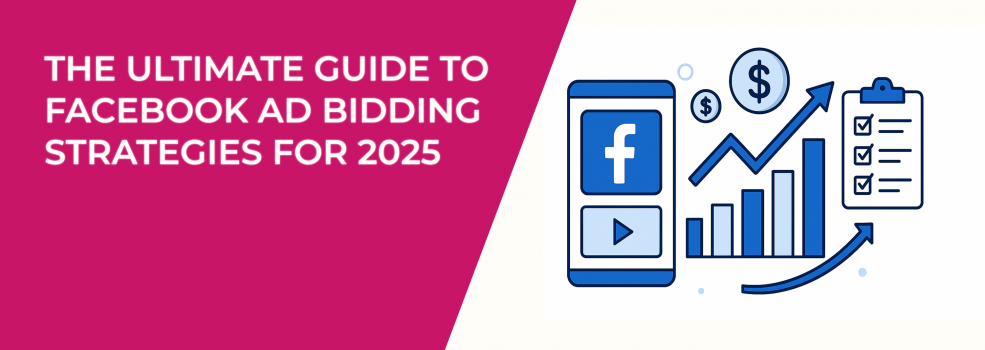Running Facebook and Instagram ads in 2025 takes more than compelling visuals or clever headlines. Behind every high-performing campaign is a smart bidding strategy — one that tells Meta exactly how to spend your budget, how aggressively to compete in auctions, and what kinds of results matter most to your business.
If you're not sure which bid strategy is right for you, or you’re struggling to scale your campaigns profitably, this guide will walk you through each approach in clear, simple terms. You'll learn what works, when to use it, and how to avoid costly mistakes with real-world examples, practical tips, and step-by-step guidance.
Let’s start with the basics.
What Is a Facebook Ad Bidding Strategy?
A bidding strategy defines how Meta (Facebook and Instagram’s parent company) spends your budget in the auction system. It affects everything from how often your ads show, to which audiences see them, to how much you pay for results.
In 2025, there are three main types of bidding strategies you can choose from:
-
Spend-based bidding – focuses on spending your full budget to get the highest volume or value possible.
-
Goal-based bidding – aims to keep your cost per action or return on ad spend within a defined target.
-
Manual bidding – allows you to set a maximum bid across auctions for complete control.
Your bidding strategy isn’t just a technical setting — it’s a reflection of your business priorities. Do you care more about reach or profitability? Predictability or flexibility? The strategy you choose should match your campaign’s core objective.
Spend-Based Bidding: For Maximum Delivery
If your main goal is to spend your budget efficiently and get the most results even if costs fluctuate, then spend-based bidding is a strong starting point.
You have two options here:
-
Highest Volume: Meta will try to get the most conversions or results (e.g. clicks, signups, purchases) for your available budget, regardless of cost per result.
-
Highest Value: Meta will focus on conversions that bring in the most value (e.g. bigger purchases), helping you maximize revenue — not just quantity.
Let’s look at some practical examples.
Example #1: You’re running a free fitness webinar and your goal is to get as many sign-ups as possible. You’re not worried about cost per lead — you just want volume. In this case, Highest Volume is your best bet.
Example #2: You sell both $10 mugs and $150 handmade vases in your online store. You want Facebook to focus on high-value orders. Highest Value helps prioritize customers likely to make larger purchases.
Before using spend-based bidding, here are some tips to keep in mind:
-
Use Highest Volume for lead generation, awareness campaigns, or promotions where scale matters more than cost per result.
-
Use Highest Value if you sell products with varying price points and want to focus on higher-value transactions.
-
Make sure your Meta pixel is passing back accurate purchase values to make Highest Value work properly.
-
Avoid these options if you need tight control over cost per action — costs may fluctuate depending on the auction.
Spend-based bidding is best when you want to maximize delivery without micromanaging cost. It's great for testing or launching new campaigns where flexibility is more important than precision.
Goal-Based Bidding: For Profit-Focused Campaigns
If you're clear on how much you're willing to pay for a result — or how much revenue you want to generate from your ad spend — goal-based bidding offers more control and predictability.
You’ll choose between:
-
Cost Cap (Cost per Result Goal): Meta aims to keep your average cost per conversion around the number you set.
-
ROAS Goal: You set a return on ad spend target (e.g. 1.5x or 2.0x), and Meta aims to deliver that return while spending your budget.
Here are two examples that show how this strategy works in real-world campaigns.
Example #1: you run a SaaS platform and know that you can profitably acquire a customer for $20. You set a Cost Cap at $20 per sign-up. Meta will try to get you as many conversions as possible without exceeding that average.
Example #2: you sell high-ticket items online, like luxury home decor. You need a return of at least 200% on your ad spend to stay profitable. You set a ROAS Goal of 2.0x. Meta will focus on shoppers most likely to generate that return.
Goal-based bidding can be powerful — but it requires careful setup and good data. Follow these best practices:
-
Use Cost Cap if you want consistent cost per conversion and care more about staying within budget than spending all of it.
-
Use ROAS Goal when your products have variable values and you're optimizing for profit, not just purchases.
-
Don’t set your targets too low. If Meta can’t find conversions at your target cost or ROAS, it may stop delivery.
-
Ensure your pixel or Conversions API is tracking purchase value and attribution accurately.
-
Be patient. Goal-based strategies can take longer to exit the learning phase, especially if your targets are strict.
If you’re profit-focused and know your margins, this strategy gives you stronger cost control and can help you scale more sustainably.
Manual Bidding: For Advertisers Who Need Full Control
Manual bidding is the most advanced option and the least forgiving. It allows you to set a Bid Cap, which limits how much Meta can bid in any auction. You get full control over your bidding behavior, but you also take on more responsibility.
This strategy is best suited for advertisers who:
-
Have internal models to calculate customer lifetime value or margins.
-
Want strict control over auction competitiveness.
-
Are willing to monitor performance closely and adjust frequently.
Use case: you run a subscription-based meal kit service. Your data science team has calculated that each new customer is worth $60 over time. You cap your bids at $30 to ensure a strong return while avoiding overpaying in competitive auctions.
Here’s what to keep in mind when using manual bidding:
-
Use Bid Cap only if you have strong data and a clear understanding of your conversion metrics.
-
If your bids are too low, Meta may not win enough auctions — and your ads might barely deliver.
-
Monitor and adjust your bids frequently to stay competitive and avoid stagnation.
-
Don’t use this strategy when testing new creatives, targeting, or products — you need flexibility during early learning.
-
Expect more volatility in delivery and performance than with automated bidding.
Manual bidding can be extremely effective, but only if you're confident in your numbers and ready to manage it actively.
Manual bidding also works best when paired with precise targeting — you can learn how to do this effectively by layering detailed targeting to build laser-focused audience segments.
Choosing the Right Strategy for Your Goals
If you're wondering which strategy to use, here’s a simple way to decide:
- If your priority is to spend your full budget and maximize exposure, spend-based bidding is your best starting point.
- If you want consistent results and are focused on profitability, go with goal-based bidding — either Cost Cap or ROAS Goal, depending on what matters more.
- If you're experienced and want full control over your bids, manual bidding can give you an edge — as long as you’re prepared to manage it closely.
The most important thing is to align your strategy with your business objective. Don’t choose a strategy based on what’s popular — choose based on what makes sense for your margins, audience, and campaign stage.
Smart Bidding Practices for Facebook Ads
As you test and refine your Facebook ad campaigns, keeping a few key principles in mind can help you get better results and avoid common mistakes:
-
Define your primary goal early. Make sure your bidding strategy aligns with your main KPI — whether it’s cost per result, total purchases, or return on ad spend.
-
Avoid underbidding. Bidding too low can restrict delivery and limit access to your best audiences.
-
Let campaigns stabilize. Avoid frequent edits that can reset the learning phase and delay performance improvements. Minimizing disruptions to the learning phase is key to stable performance — here's a step-by-step guide to exiting the learning phase faster.
-
Use separate campaigns for different bid strategies. Especially with Advantage+ budgets, keep strategies organized to avoid performance conflicts.
Stick to these essentials, and you’ll be in a strong position to build campaigns that are both efficient and scalable.
Final Thoughts
Your bidding strategy is one of the most important levers you can control in Facebook advertising. It shapes how Meta spends your money — and how effectively your ads reach the right people.
Whether you’re looking for fast growth, predictable costs, or long-term profitability, there’s a bidding strategy that fits your goals. But it only works if you take the time to understand it and apply it with clarity and discipline.
So before you launch your next campaign, ask yourself: what’s my real goal, and how much am I willing to pay to achieve it?
Once you know the answer, choosing your bidding strategy becomes a powerful step toward more efficient, scalable, and profitable advertising.

